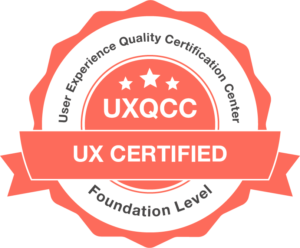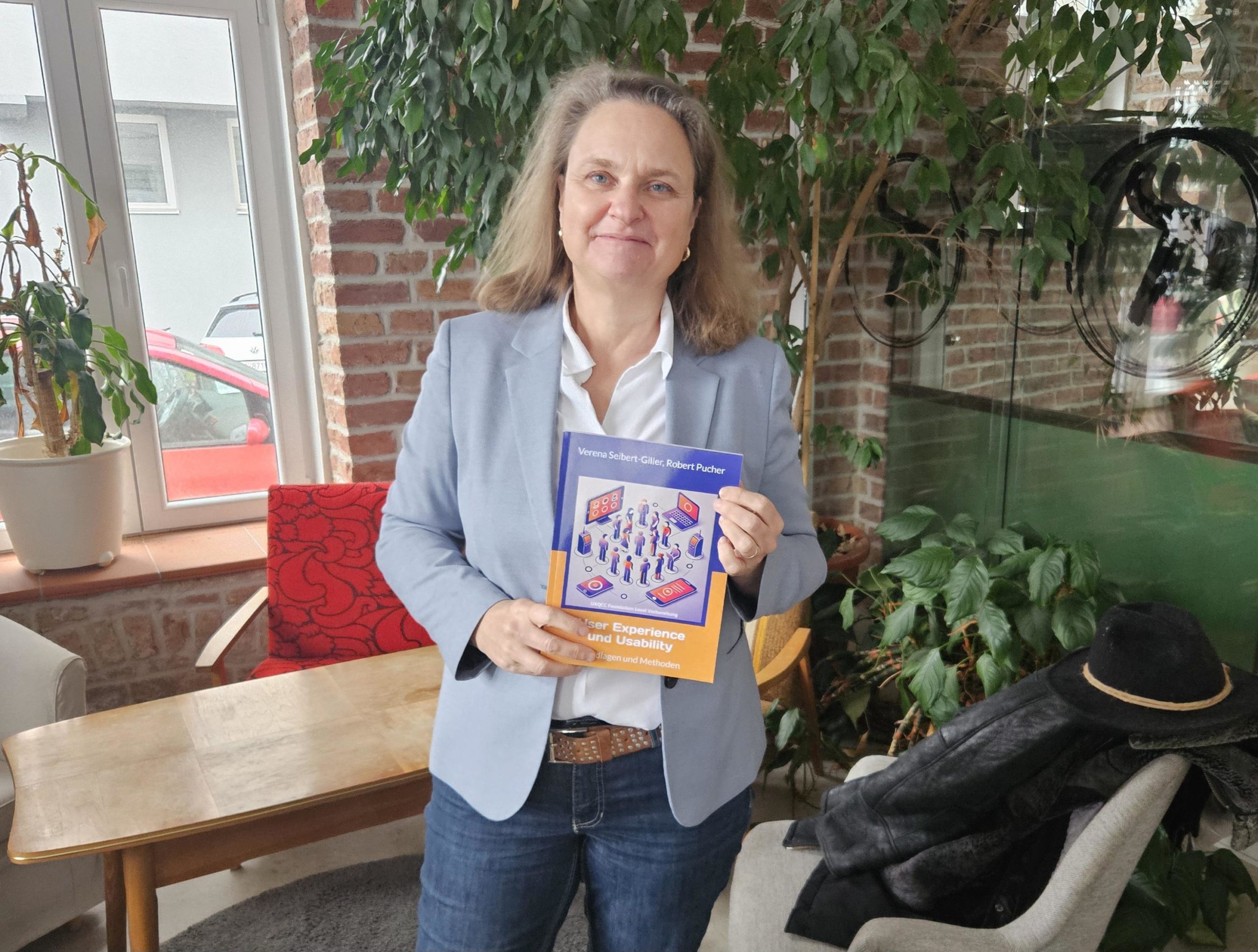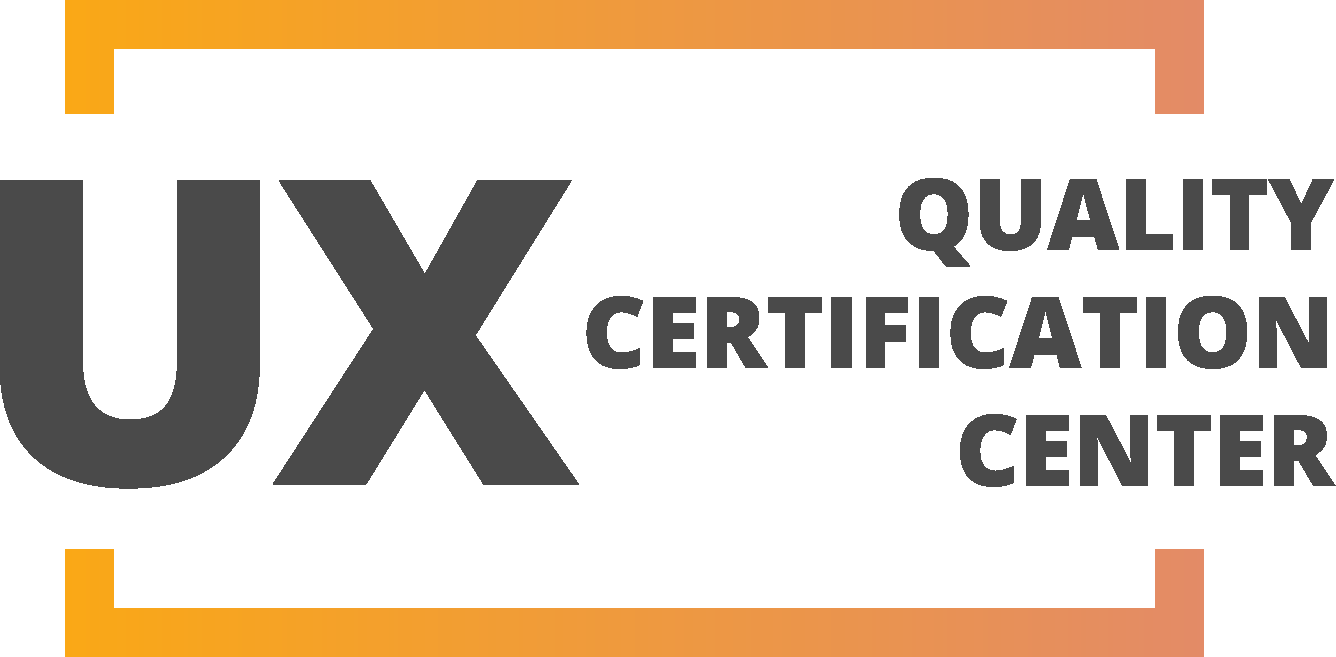CPUE Foundation Level
2,5 days
Build your basic UX skills
The foundation level certification attests the holder the knowledge and skills to work in teams on user experience design and usability engineering projects.
On the right, you see a sample of the CPUE foundation level badge you get after completing the course. You can use it on your social media profiles and your resume.

The learning objectives include
Principles of usability and user experience
- What is usability, and what is user experience?
- What is a user-centered design approach and process?
- What benefits does this approach bring to the various stakeholder groups?
- What risks and problems does a lack of usability cause?
- Why is “usability” not the same for different systems?
Basics of human perception and information processing
- What is the subjectivity of human perception?
- How do we read and visually perceive our environment?
- How do we perceive colors, and what divergencies occur?
- What are mental models?
- What are the Gestalt laws?
Usability engineering process and methods
- What is the Usability Engineering Life Cycle?
- What phases and cycles does it encompass?
- What is a context analysis, what methods are applied?
- What is UX prototyping, for what is it used?
- What types of prototypes are appropriate in which project contexts?
- What is usability testing, for what is it used?
- What UX methods exist, with users and without users?
- What questionnaires are available to assess usability and UX from the user’s perspective?
UX in various software development processes
- How can UX related activities be included in traditional versus agile development processes?
- What are pitfalls and problems when including UX activities?
- What are the beneficial organizational criteria for the successful integration of UX?
Standards, guidelines, and accessibility
- What is the ISO 9241 standard, focusing on parts 110 and 210?
- What are the Web Content Accessibility Guidelines of the W3C?
- What is the practical benefit of these standards and guidelines in a project?
Target audience
- Software Engineers.
- Scrum Masters.
- UX & UI Designers.
- Quality Managers.
- IT Project Managers.
- Newcomers.
- Students.
- Marketing Managers.
Please note: The Foundation Level certificate qualifies and enables you to
take the Advanced Level certification.
If you completed the UXQCC certification course, or are a UX professional and only want to get the UXQCC certificate, you can buy an exam code here.
The UXQCC exam is provided and monitored by a neutral online examiner – ProctorU.
At the end of the workshop, participants will be able to
Explain the principles of usability and user experience
- Describe the concepts of usability and user experience and name at least three underlying criteria.
- Describe a user-centered design approach and process, and name three advantages.
- Explain which various stakeholder groups benefit from this approach.
- Name risks and problems caused by a lack of usability and name three examples.
- Explain why “usability” is not the same for different systems.
Describe the basics of human perception and information processing
- Explain the subjectivity of human perception and name respective problems for usability.
- Explain how we read and visually perceive our environment and draw a schema of our visual field.
- Explain how we perceive colors and what divergencies occur and name three examples of deficiencies.
- Describe what a mental model is and name three examples relevant for UX.
- Explain the Gestalt Laws and showcase some UI examples.
Describe the usability engineering process and its methods
- Illustrate the Usability Engineering Life Cycle.
- Illustrate the phases, cycles that it encompasses.
- Explain a contextual analysis and exemplify what methods are applied.
- Explain UX prototyping and showcase for what it is used.
- Explain different types of prototypes and the reasons to use them in varying project contexts.
- Illustrate what usability testing is and name three application examples.
- Plan and conduct a usability test of a website.
- Explain which methods exist without users, and carry out walkthroughs and heuristic evaluations.
- Cite at least three questionnaires that are available to assess usability and UX from the user’s perspective.
Explain UX in various software development processes
- Describe how UX related activities can be included in traditional versus agile development processes.
- Name at least three potential pitfalls and problems.
- Name at least three beneficial organizational criteria.
Describe relevant standards, guidelines, and accessibility
- Explain the ISO 9241 standard, focusing parts 110 and 210 and name examples of their application.
- Explain the concepts of the Web Content Accessibility Guidelines of the W3C and name three examples of their application.
- Describe the practical benefit of standards and guidelines in a project and explain at least one application.
Your exam preparation
In addition to any of your UXQCC certification course, you can choose between
- a full textbook, including numerous examples, cases, glossary, and 60 representative questions/answers or
- a booklet covering 111 representative questions/answers and an extended glossary.
Both are available in English and German on Amazon.
English: https://www.amazon.de/User-Experience-Usability-Basics-Methods/dp/3950564527/
Steps to get your UXQCC certificate:
- Register for a UXQCC certification course.
- Complete your course.
- Get an exam code after completion of the course.
- Prepare for the exam.
- Complete the exam.
- Announce your latest acquired UX skills to the world.
The sooner you complete the exam, the better because you can publish your newly acquired UX skills and uplift your career.
If you do not take the exam directly after the course or within three months, the probability of you doing the exam later goes down to a minimum. We recommend taking the exam immediately after completing the course.

Book your UXQCC Foundation Level training at a local training provider near you
Our training calendar is NOW OPEN. See your local training providers’ schedule to find training dates and places convenient for you. If there is currently no date available, don’t hesitate to contact your local training provider to arrange a training date.
Austria |
|
FH Technikum Vienna |
Vienna |
UX Focus |
Linz |
youspi |
Graz |
China |
|
UXPA China |
Shanghai |
Germany |
|
Playbook Research |
Berlin |
Jordan |
|
Ahmad Alhuwwari |
Amman |
India |
|
Human Factors Research & Design |
Bangalore |
UX Expert |
Pune |
Mazedonia |
|
AcademyOfUX |
Skopje |
Mexico |
|
Sperientia Studio+Lab |
Ciudad de Mexico |
South America |
|
Playbook Research |
Spanish – online |
Spain |
|
Playbook Research |
Spanish – online |
Taiwan |
|
UXTesting Inc. |
Taiwan |
USA |
|
UXR Coach |
Cold Spring |
No training provider near you? Book your training with a global training provider
If you cannot find a local training provider near you – get in touch.
Our global trainer elite can cover areas without local training providers.

Johannes Robier
CEO @youspi, UX Speaker

Tania Lang
Principal at PeakXD, Trainer, Coach & Mentor

Verena Seibert-Giller
UX & Human Behavior Consultant, Trainer
